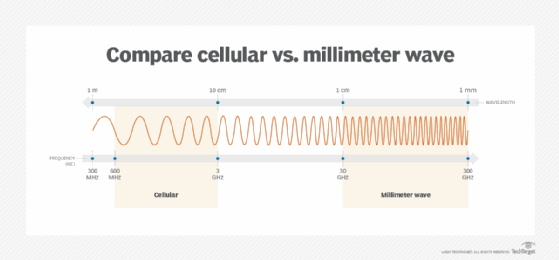What is millimeter wave (mmWave)?
Millimeter wave (mmWave) is a range of electromagnetic frequencies that exist between microwaves and infrared light. Millimeter waves have wavelengths between 1-10 millimeters and occupy the 30-300 GHz range of the electromagnetic spectrum. In the telecom and wireless industry, the definition of mmWave might also include bands starting at 24 GHz, because some 5G deployments and Wi-Fi standards that use mmWaves operate there.
mmWaves have very short wavelengths and occupy a range of frequencies that have large amounts of unused spectrum. This enables the creation of extremely wide communication channels that can transfer large volumes of data at high speeds. The high throughput that mmWaves provide makes this frequency range highly suitable for a wide range of bandwidth-intensive applications, including high-quality video transmission, augmented reality, virtual reality, radar, satellite links and next-generation Wi-Fi systems. For example, mmWaves are used in some 5G deployments to enhance network performance in areas where existing cellular coverage requires more bandwidth and speed.
The mmWave frequency band is also known as the extremely high frequency band by the International Telecommunication Union (ITU). In the context of 5G, this frequency band is also commonly referred to as 5G high-band or high-frequency 5G.
What is the difference between 5G and mmWave?
5G is a cellular mobile network standard developed by the 3rd Generation Partnership Project. It’s also a global standard defined by IMT-2020, an ITU standard for providing wireless broadband communication. To provide full coverage, 5G operates across three spectrum ranges -- low-band, mid-band and high-band. Millimeter wave refers specifically to the high-band range.
In most 5G deployments, the low- and mid-bands can provide broad, reliable coverage. In densely populated areas, however, telecom carriers sometimes supplement these frequency bands with mmWaves to minimize latency and handle heavy data traffic.
By combining low-, mid- and high-band 5G in a layered spectrum strategy, carriers can balance coverage, capacity and performance. The low- and mid-band frequencies ensure reliable wide area network (WAN) connectivity, and supplemental mmWaves boost network capacity in hotspots known to experience high demand spikes.

How mmWaves work in 5G
Millimeter waves provide 5G's highest data transfer rates and lowest latency by using large chunks of contiguous bandwidth. This is possible because the portion of the electromagnetic spectrum that mmWaves occupy has more unused spectrum available than lower frequency bands. Lower bands are already crowded with existing services such as TV, radio and 4G.
Although mmWave plays an important role in 5G, its frequencies aren't used in every 5G deployment. The chief drawback of using mmWave is that while the frequency band's short wavelengths are highly directional, they're easily blocked by physical objects, and their signal strength attenuates or drops off quickly with every foot of distance.
While mmWaves enable high-speed, low-latency wireless communication over short distances, their short wavelengths require line-of-sight or near-line-of-sight transmission paths. To compensate, millimeter wave signals in 5G networks are transmitted by small, low-power base stations called small cells. Small cells are compact, low-power radio units that operate at very high frequencies and are designed specifically to cover short distances.
When a 5G-enabled device is within range of an mmWave small cell, it connects to the mmWave frequencies -- which are typically between 24-40 GHz in most 5G deployments. The small cell acts as a base station and uses a multiple-input, multiple-output (MIMO) antenna array to transmit and receive data to and from the connected device. When the device using 5G moves out of mmWave range, the connection automatically hands off to a nearby mid-band or low-band 5G cell. This ensures continuous service.
Does Wi-Fi use mmWave?
Millimeter wavelengths are typically associated with 5G wireless communications, but they can also be used for Wi-Fi networks. In fact, IEEE 802.11ad WiGig and IEEE 802.11ay standards already operate in the 60 GHz band, and this falls within the mmWave range.
Industry sources also predict that Wi-Fi 8 will use mmWave operations to support high-demand scenarios. Research into this area is already progressing, with the IEEE paper “Wi-Fi 8: Embracing the Millimeter-Wave Era” stating that the incorporation of mmWave band into Wi-Fi 8 would be a "natural progression for an increasingly connected world."
The paper's authors expect that by 2028, new frequency bands will be needed to accommodate internet of things (IoT) devices and real-time applications that require high throughput and low latency. However, using mmWaves to improve data transmissions in Wi-Fi 8 might not be easy to realize.
mmWave's line-of-sight requirements, signal attenuation and the need for beamforming and MIMO technology in small cells are likely to make the integration of millimeter waves into Wi-Fi 8 technically complex and costly. It's expected that further research will be needed to implement mmWaves at scale.
Advantages of millimeter wave
Millimeter wavelengths offer the following benefits for high-performance wireless communication:
- mmWaves can be transmitted over wide channels to improve data transfer speeds and reduce latency.
- Antennas for mmWave devices are typically smaller than for other frequencies, as antenna size is inversely proportional to wavelength. Small cells can group multiple antennas together in an array and focus radio energy in specific directions to improve signal strength.
- Sensors that use mmWaves can detect smaller objects and measure distance, velocity and angle with greater precision than lower-frequency radar or ultrasound systems.
- The short propagation distance of mmWaves allows many access points to cover the same general area without neighboring cells causing interference.
- In Wi-Fi wireless local area networks (WLANs) like WiGig, the small coverage zones that mmWaves require allow access points to reuse channels across adjacent areas without causing interference.
- Because mmWaves operate at high frequencies and offer wide bandwidths, they can transmit large amounts of data very quickly. This makes them ideal for real-time, data-intensive IoT applications, such as self-driving cars and robotic systems, that rely on rapid data exchanges and near-instant response times.
Disadvantages of millimeter wave
Despite the noticeably large increase in data transmission speeds that mmWaves offer, their use has some significant disadvantages, including the following:
- mmWave signals have a very limited range -- typically only a few hundred meters.
- Millimeter waves travel primarily by line of sight and are easily blocked or weakened by physical objects such as billboards or office buildings.
- Atmospheric gases, humidity and rain can absorb mmWave signals and reduce their range and strength.
- Human and animal bodies contain water, and water absorbs electromagnetic energy. If there are too many people between an mmWave transmitter and receiver, it can degrade signal strength.
- mmWave signals require line-of-sight or near-line-of-sight, and this can make network planning more complicated.
- mmWave deployments that use MIMO antennas, beamforming arrays and precision radio frequency modules are more expensive to deploy than lower-frequency systems.
Millimeter wave uses and applications
Millimeter waves can be used in a wide range of products and services that require fast, high-capacity and short-range wireless communication or high-resolution sensing. Popular use cases for mmWaves include the following:
- Delivering ultra-fast 5G mobile broadband in dense urban areas such as train stations and downtown districts.
- Providing fixed wireless internet, a type of ultra-fast internet over the air, to locations where running fiber isn't practical, such as rural areas.
- Supporting multi-gigabit data transfers in next-generation Wi-Fi systems.
- Enabling high-capacity wireless backhaul links between small cells.
- Detecting nearby vehicles, obstacles and pedestrians in automotive radar systems that operate around 76-81 GHz.
- Scanning passengers and baggage in airport security systems.
- Inspecting materials and equipment in industrial environments.
- Building high-bandwidth WLANs and short-range personal area networks.
- Enabling low-latency communication among industrial robots and control systems in smart factories.
- Avoiding car accidents in autonomous vehicles that use mmWave sensors for collision avoidance and adaptive cruise control.
- Supporting real-time, high-capacity wireless links for emergency response in small, local areas.
- Observing molecular gas clouds, dust and star-forming regions that aren't visible in optical wavelengths.
Where is mmWave 5G available?
As of 2025, commercial mmWave 5G is available in the U.S., Japan, South Korea, Australia and Italy. The UK, Finland, Singapore and Taiwan currently have pilot or limited deployments in place, and China remains focused primarily on mid-band 5G rather than mmWave 5G.
In the U.S., the following three major carriers offer mmWave 5G services:
- AT&T offers mmWave 5G under its 5G+ branding, operating in 24 GHz, 39 GHz and 47 GHz bands. As of 2025, AT&T's mmWave 5G is available in more than 50 U.S. cities, typically covering high-traffic zones such as arenas and campuses.
- T-Mobile operates mmWave 5G in the 28 GHz (n261) and 39 GHz (n260) bands, complementing its nationwide mid-band (2.5 GHz) and low-band (600 MHz) 5G coverage. It uses dual connectivity to combine mid-band and mmWave spectrum for uplink speeds that exceeded 2 Gbps in 2024 field tests.
- Verizon was the first major U.S. carrier to launch commercial mmWave 5G called Ultra-Wideband in 2019. It primarily uses 28 GHz (n261) and 39 GHz (n260) bands for ultra-fast connections in dense urban areas, stadiums, airports and business districts.
Comparison with other spectrums
mmWaves occupy the highest portion of the radio frequency spectrum used for modern communication. Compared with lower-frequency bands -- including VHF, UHF and microwave -- mmWaves offer more bandwidth and faster data transmission.
When considering whether to use mmWave frequencies, it's important to balance the advantages that millimeter waves offer with the need to compensate for signal loss by deploying dense networks of small cells and using advanced beamforming and MIMO technologies to maintain reliable coverage.
mmWave vs. microwave
Microwaves and millimeter waves both belong to the electromagnetic spectrum, but they occupy distinct frequency ranges and serve different roles in communication, sensing and imaging technologies.
Microwaves are used to transmit data, voice and video signals wirelessly over medium and long distances. Their frequencies -- 300 MHz-30 GHz -- can carry large amounts of information and penetrate obstacles. This makes them ideal for cellular networks, Wi-Fi, satellite communication, radar and television broadcasting.
In contrast, mmWaves occupy the 24 GHz -- sometimes 30 GHz -- to 300 GHz range. They can transmit data faster, but their transmission range is short, and they generally require line-of-sight connectivity.
Today, microwaves are used for long-range connectivity in wireless systems, while mmWaves are used to boost the performance of data-intensive applications. Together, they enable everything from Wi-Fi to the most advanced 5G and next-generation wireless technologies.
Although 5G speeds are significantly faster than 4G, due to the range limitations of 5G, 4G LTE is unlikely to be phased out anytime soon. Learn more about how 4G and 5G compare.






